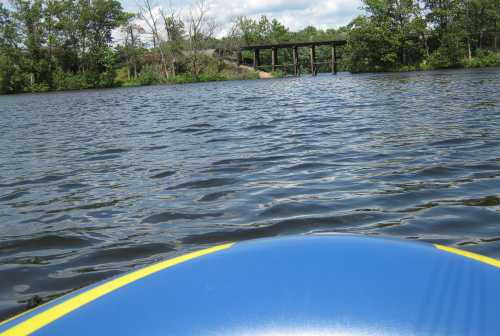
From water level from a rubber inflatable boat, the area looks like this.
I have flown kites from a canoe, but never launched a kite from such a small craft.
Flying from a larger boat like a pontoon would be easy, That much floor space would be like flying a kite from land.
But I have these little inflatable crafts, low cost and easy to transport and I can put them in the water at any little river bank.
I go places like where the kayakers and tube float people do.
This 3-man dinghy has enough space to let me launch and retrieve a kite while I am on the water.
I prepared a kite string winder and a mast to help control the string.
Being in such a limited space, I can't do the same things that work so well when launching a kite from land,
such as running to generate some air flow to get a kite up into the real wind,
or 'long lining' a kite to get a launch from the calm air at ground level and 'jump' the kite up into the wind above.
| Basically, I have to do everything from a sitting position in a little boat, just above water level. |
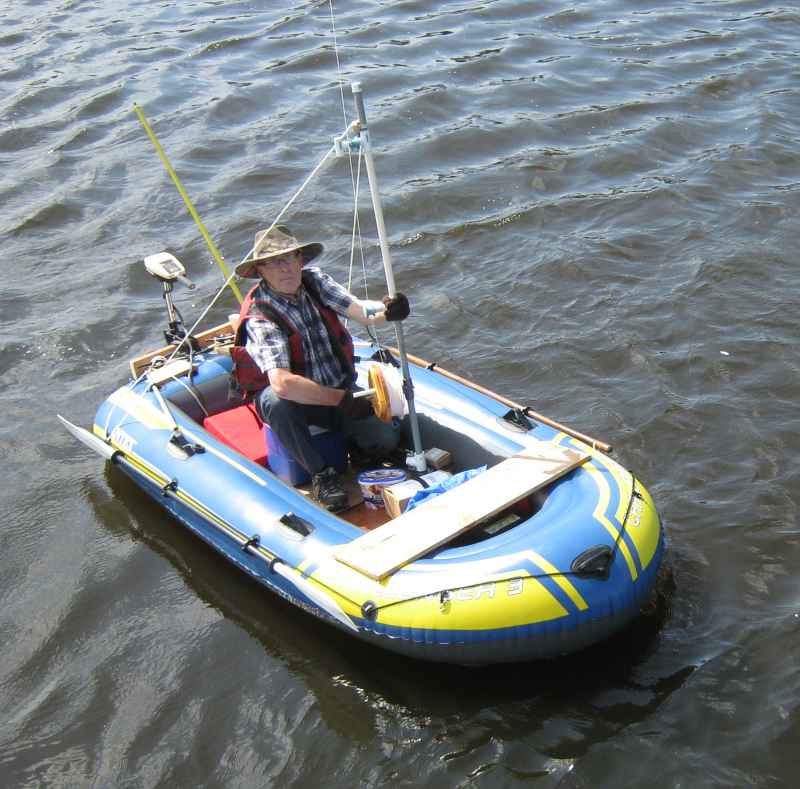
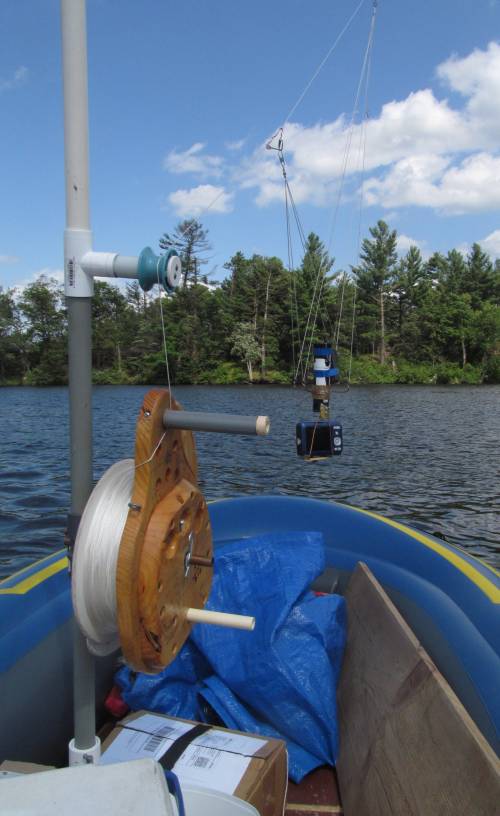 The mast holds the string reel.
The mast holds the string reel.
And I have pulleys above that, and I put the string as high as needed.
I assemble the kite; its a delta conyne and its simple to prepare, it only has one cross spar, and when it is assembled, it is 8 feet wide. Compare that to this boat that is only 4 feet wide.
I first hang the kite from the top of the mast, and then I motor or row around to find a place where a puff of wind might come down to water level and make the kite start flying. That might take 15 minutes.
Then I let out line and get the kite up about a hundred yards so it it up in the steady powerful wind that is about 5 times higher than the tree tops.
Finding wind on a small body of water can be hard, if it a river that is 80 feet wide and has 50 foot trees nearby. For some sites, I watch the weather forecast and line up the wind direction with the length of the river, so the air has some 'fetch' in the valley between the trees. You can get good at being a weatherman when you are experienced with flying kites.
For the non-kite flyers in the group, for this version of kite aerial photography, the kite is launched and raised to an altitude at least 5 times higher than any obstacles, such as trees, so the kite can fly steady and with just enough power. Then the camera is added to the string and then more line is let out so the kite and camera rise higher.
I use a picavet (a string sling with two hooking points) to hold the camera.
If I used a pendulum with a single hook, this would easier, but I like the quality of the pictures from a picavet.
After the kite is flying high in a steady wind, I attach the picavet to my kite string. If I was standing on ground, this would be easy. From this little boat and all by myself, I can only work with what I can reach while sitting down.
In this picture, I moved the string to the blue pulley above the reel, that's high enough but close enough that I can reach the kite string, and the camera is hanging freely in the air and still over the boat.
Then I unreel the string to let the camera go higher. And watch that the kite has enough power to keep lifting the camera higher as it goes beyond the edge of the boat.
This is risky from a boat, if the wind slows down unexpectedly, and the camera drops, my only recourse is to wind in the line, which also brings the camera lower to the water, a no-win situation.
I wouldn't want a splash down; my camera is not water proof. A waterproof camera would add more weight which makes the job more difficult than it is.
If the power of the wind is unpredictable while raising the picavet and camera, I move the line to the pulley 4 feet above. So if I had to retrieve it fast, I also have the small advantage of keeping the camera a few extra feet above the water during this risky time.
I can have my hands full. There are lines to support the top of the mast.
It's like rigging a tall ship, where the mast is strengthened by guy lines.
And I have a mess of anchor line to mind, under foot.
I anchor the boat, otherwise the pull of the kite might drag me into the forest. The kite can pull with about 6 pounds of force, so this voyage can be like a sail boat. Like a mariner of old times, I fear being blown onto a lee shore.
|
After I did the trip shown above, I improved the mast so I gain 3 more feet of height to help launch the kite. In its low position, I can reach the pulley and put the string on it. Then I raise the 'periscope' and lock it in position, then hoist the kite up to that higher level, and wait for the wind. The next three pictures demonstrate the 'periscope' that slides up. Don't expect me to show a picture or video of this launch method, I am busy enough just getting a launch without also getting pictures of it. This method might also apply to other difficult places to launch a kite, such as, from a wheelchair. |
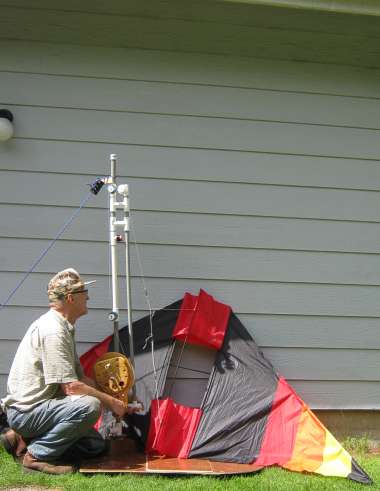
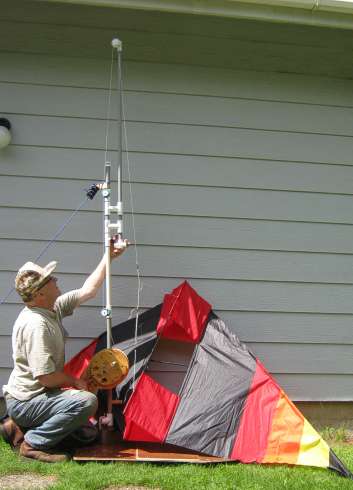
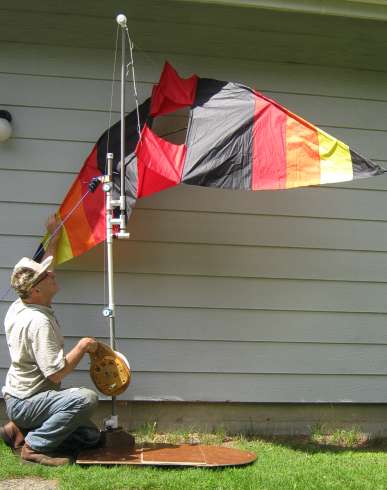
|
Below is an aerial view of the area of my subject. Not much to look at this time, the train didn't come through. I can almost see the 'Green Trail' in the distance on the far side of the water. So there's two railroad tracks in this scene, the active one up close, and the Trail which was abandoned and routed to the near track, 50 years ago.
To catch a train would have also called for much better timing |
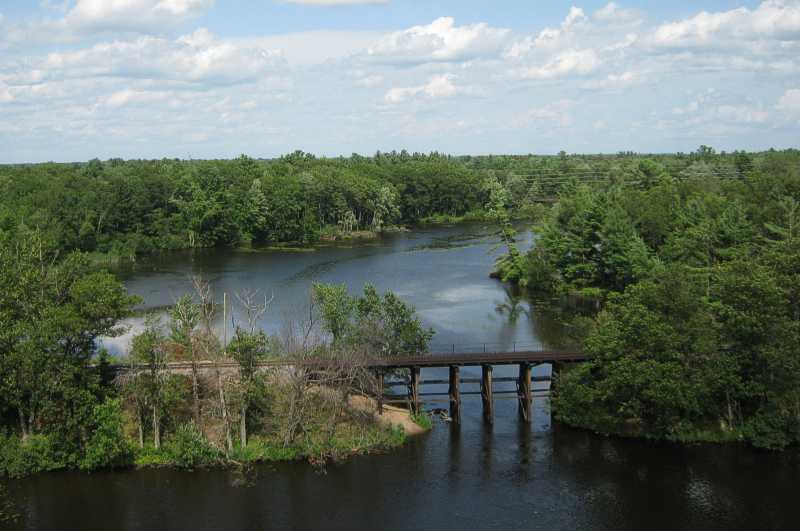
|
So, here is another one of my special home made combinations of equipment that allows me to take a few pictures from a different perspective or location. I can spend a lot of time preparing the hardware and processing ideas. All to get a few dozen pictures which boil down to a few for my web pages. It's a time consuming hobby.
Here's a link to a page of aerial pictures from a challenging little river location.
|
This page was filmed and wrote about in August, 2019.